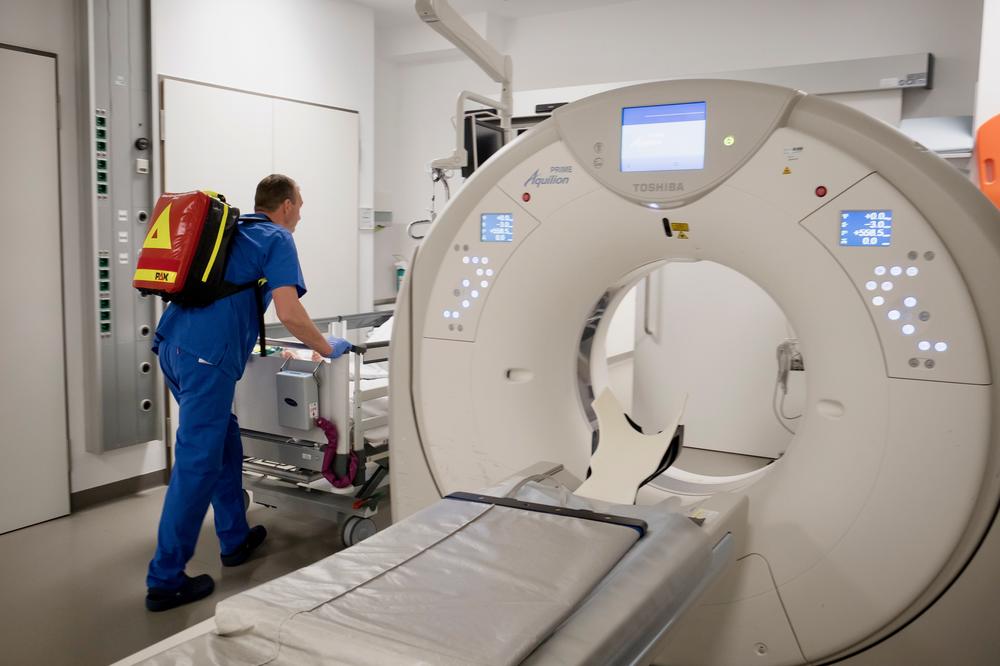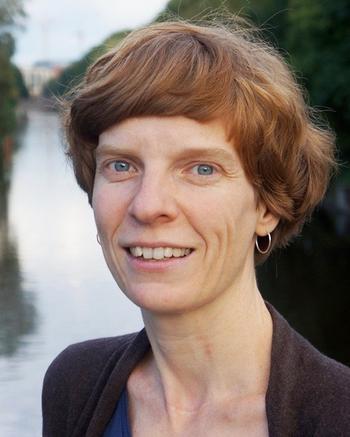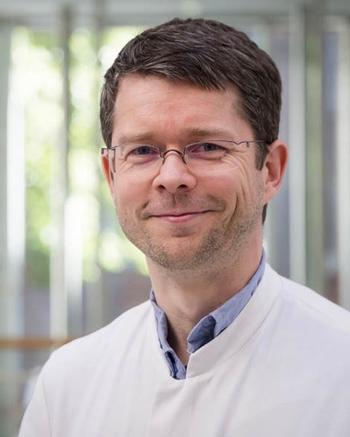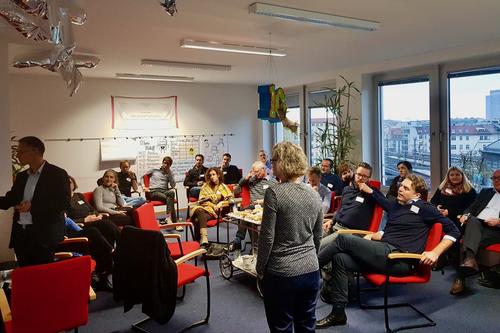Artificial intelligence in radiology
Digitalization is transforming the healthcare system, but under what circumstances is the use of artificial intelligence considered to be trustworthy? This issue was explored as part of a transdisciplinary project, taking radiology as an example.
May 13, 2020
The number of radiological examinations at Charité increased by five percent last year. The image is a computed tomography (CT) scanner.
Image Credit: Britta Radike
Every day, radiologists study thousands of medical images from X-ray machines, computed tomography (CT) scanners, or magnetic resonance imaging (MRI) machines. They examine bone fractures, inflammations, altered tissue, and tumors. It is a profession that requires a lot of time and focus. In the near future, physicians may be increasingly aided by artificial intelligence (AI) as computer programs are able to search for and flag abnormalities.
The ethical and societal issues that are associated with this development were explored in a transdisciplinary stakeholder consultation within the framework of the Artificial Intelligence in Radiology (KIRA, derived from the German translation: Künstliche Intelligenz in der Radiology) project, initiated and supervised by Technische Universität Berlin on behalf of the Berlin University Alliance. Scientists from the four alliance institutions – Freie Universität Berlin, Humboldt-Universität zu Berlin, Technische Universität Berlin, and Charité – Universitätsmedizin Berlin – met for an exchange of information with important individuals from the field: Patients, doctors, radiology assistants, and computer scientists. Their questions, recommendations, and ideas have now appeared in a report.
“I welcome the fact that it is not just scientists but rather many different people from various fields who are considering the diverse aspects of digitalization – it is something that will fundamentally change our society,” says Anke Nowottne, who herself has had to undergo a number of radiological examinations as a patient in recent years. On top of this, she is professionally involved with AI in her job as a data specialist at the German Federal Printing Office (Bundesdruckerei). In November 2019, she met with the KIRA project team as well as 18 other project partners for a workshop focusing on the question: Under what circumstances is the use of artificial intelligence in radiology considered to be trustworthy?
During the kick-off event, the KIRA group first conducted two different role plays carried out by real doctors and patients in order to provide an overview of the different steps of a radiological examination. The scenario: A patient comes into surgery general practitioner office with chest pains, a symptom that indicates possible heart disease. The general practitioner refers her to a radiologist, where she is undergoes a CT scan and receives a medical diagnosis, and related treatment recommendation. Two different variants were simulated: In the first case the radiologist used AI programs; in the second she did not. These circumstances gave rise to many questions and discussions among the participants.
Prof. Dr. Marc Dewey is Deputy Director of the Department of Radiology at Charité Campus Mitte and spokesperson for the scientific project team.
Image Credit: Britta Radike
“What was so special about KIRA was that everyone who has an involvement in radiological examinations in practice was heard in detail,” says Professor Marc Dewey, Deputy Director of the Department of Radiology at Charité Campus Mitte and spokesperson for the scientific project group. All participants were questioned multiple times after the initial workshop, both individually and in groups: What happens if the software gets it wrong? Is it then the doctor or the AI developer who is liable? And, what if radiologists come to a different conclusion than the program? What leeway do they have here? The answers and questions raised by the participants themselves were recorded and evaluated in a consultation phase over several months by means of individual and group telephone interviews. The Deliberative Delphi method, developed by Ralf Grötker from the Explorat agency and adapted to this particular topic together with the project coordinator Berit Petzsch from Technische Universität Berlin, was used in this context.
Data protection was another important aspect discussed by the group. After all, even if medical images are made anonymous, personal information could still be obtained from them. For example, a three-dimensional image of someone’s face could be reconstructed from the MR images of their head.
Participants were surprised that a CE marking of the European Union is sufficient to approve an AI software for radiological image analysis. Unlike for drugs, randomized studies are not carried out for AI tools in order to investigate whether their application actually has advantages for patients. “Many participants were of the opinion that a more vigorous trialing process should be in place,” says Marc Dewey. This point could play a role in gaining confidence in these new technologies.
A diagnosis or therapy recommendation by the doctor needs to be justified and comprehensible. AI programs should therefore be designed in such a way that makes them highly transparent from the perspective of its respective users. “Of course users need e to know on what basis the program derives a particular decision,” says Marc Dewey. “Decisions should be visualized and explained more clearly, not only for the radiologists but also for patients.”
“AI programs are still not comparable to the top experts.” Marc Dewey
One of the biggest challenges, explains Marc Dewey, is convincing a group of physicians that the use of AI neither devalues nor makes their profession obsolete. “Studies have shown that AI programs are just as accurate as an average trained radiologist. However, they are still not comparable to the top experts.” Artificial intelligence should not replace medical doctors but could be a potentially helpful screening aid for determining whether or not abnormalities are relevant or not.
A single CT or MRI examination produces thousands of images. “The question of whether and under what circumstances radiologists consider AI programs in their daily working life as a stress factor or a helpful resource has a direct impact on their performance, satisfaction, and well-being in the workplace,” says Jenny Wesche, a research associate in the Department of Education and Psychology at Freie Universität Berlin. Together with her colleague Annekatrin Hoppe, a professor at the Institute of Psychology of Humboldt-Universität zu Berlin, she intends to address this central issue for research in joint projects that build on the achievements realized by KIRA.
Radiologists require between five and thirty minutes per patient in order to accurately analyze the images. The number of radiological examinations is also on the rise – there was an increase of five percent at Charité last year, for example, which points to the economic dimension of these changes. “In addition to probable effects on efficiency, the changing perceptions of quality among patients, noticeably evolving requirements in competence for all participants involved in the process, as well as considerable expansion of IT investments must be taken into account. This can quickly lead to so-called innovation barriers,” explains Martin Gersch, a professor in the Department of Information Systems at Freie Universität Berlin and Principal Investigator at the Einstein Center Digital Future, who is currently researching, among other things, the digital transformation of the healthcare system and is a representative for these aspects within the KIRA team.
Scientists from the four alliance institutions met for an exchange of ideas with important individuals from the field.
Image Credit: Marc Dewey
The scientists involved are now using the results obtained from KIRA as a starting point for further research projects. “Thanks to the superb overview that the consultations have created for the radiological processing steps, we will now be able to more systematically substantiate and further research the relevant issues on the use and acceptance of AI in radiology,” says Marc Dewey. From a philosophical point of view, it is important for us to examine what trust can mean in this new form of human-machine interaction and what regulatory conditions would have to be in place in order to ensure a trustworthy design and implementation model. Birgit Beck, a professor of philosophy at Technische Universität Berlin, addresses such conceptual and ethical issues as a member of the project team.
According to Marc Dewey, the transdisciplinary project has succeeded in collating all of the pertinent perspectives and pressing questions, and these can now be addressed by the different disciplines involved in the KIRA project, working both collaboratively and on a subject-specific level: philosophy, medicine, economics/business information technology, and psychology.
Anke Nowottne is also looking forward to the results. “It has once again proved to be particularly important in the health sector to create regulatory measures that ensure that, above all, patients benefit from the positive potential of digitalization,” she says. She would like to see more moderated discussions on the issue that do not cause further polarization by either simply celebrating the new technologies as the means of salvation or completely rejecting it by principle. Anke Nowottne also believes that it is important for children to be taught at an early age to have a critical and self-determining approach when it comes to handling data. “We cannot stop digitalization, but we can shape it.”
Further Information
Solutions to the major societal challenges of our time can only be found by our various key societal figures coming together to exchange ideas. Over the coming years, the Berlin University Alliance will develop further research forums under the leadership of Professor Christine Ahrend, First Vice President of Technische Universität Berlin, who says, ”Transdisciplinary research and collaboration will be important in the future for solving the biggest societal challenges. As Berlin University Alliance, we are entering uncharted territory in the field of cutting-edge research with our in-depth exchange formats. We currently have the topic Social Cohesion on our agenda, however we are certain to tackle more Grand Challenges and explore them together with society.”
One of the main goals of the Berlin University Alliance is to establish and support a multi-directional knowledge transfer network (Fostering Knowledge Exchange). Scientific ideas should not only be carried into society but external ideas and perspectives should also be returned into the research process. The Artificial Intelligence in Radiology (KIRA) project also emerged from a transdisciplinary pre-research forum. In October 2018, a workshop on the topic of New Health which focused on addressing fundamental questions of digitalization and ethics in the health sector was set up for the first time by the three main universities in Berlin – Freie Universität Berlin, Humboldt-Universität zu Berlin, Technische Universität Berlin, and Charité – Universitätsmedizin Berlin, together with Berlin scientists from various disciplines (medicine, ethics, mathematics, computer science, health management, economics) along with individuals from politics, business, and culture. One project team from Technische Universität Berlin had developed concrete case studies that were discussed at the event: What progress has there been on automated diagnostics? How is data tracking used in hospitals? How are nursing robots used?




